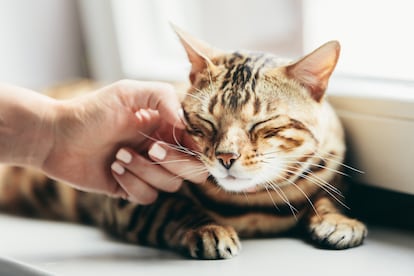How do cats purr? New findings reopen the arguments over felines’ biggest mystery
Fibrous ‘pads’ on the vocal cords allow them to emit low-frequency sounds, although the scientific debate has not been closed

For a cat lover, one of the most pleasant sounds is the low rumble your feline friend makes when you scratch them lightly behind the ears. Different myths have been created to try to explain why the sound is produced, and even the supposed healing effects it might have for humans. However, the real mystery for the scientific community is how cats produce these purrs. A recent study published in Current Biology may finally have the answer: it is more similar to snoring than a voluntary muscle spasm.
While big cats like lions and tigers are capable of loud roars, domestic cats can only produce low-frequency purrs. Researchers have wondered how they manage to generate these vocalizations, which are typically between 20 and 30 hertz (Hz). Domestic cats are small, most weighing around 10 pounds, and these frequencies are typically only seen in large species such as elephants, which have much longer vocal cords. Only raccoons emit a similar purr, although they are not able to do it with the intensity variations that domestic cats can create.
According to research by Christian Herbst of the University of Vienna (Austria), purring appears to come from “pads” embedded in the vocal cords of domestic cats, which add an additional layer of fatty tissue and allow them to vibrate at low frequencies. The larynx does not seem to need any stimulation from the brain to produce a purr.
Most noises that mammals make, including cat meows, are produced similarly: a signal from the brain causes the vocal cords to press together, and airflow through the larynx causes the cords to collide hundreds of times per second and produce a sound. This process, known as self-sustaining oscillation, is a passive phenomenon: once the vocal folds begin to vibrate, no further neural information is required to keep them functioning. But some scientists believed that purring was different.
The so-called active muscle contraction hypothesis maintains that to produce a purr, domestic cats actively contract and relax their laryngeal muscles about 30 times per second. Based on measurements of electrical activity in the larynx muscles in purring cats, the idea caught on and has been a common explanation for cat purring ever since.
But the new study calls this into question. The team has discovered that cyclical muscle contractions are not necessary to generate purrs. For this research, scientists removed the larynxes of eight domestic cats that had died from incurable diseases: they brought their vocal cords together and pumped warm air through them. By isolating the larynx in this way, they guaranteed that any sound was produced without muscle contractions or any impulses from the brain. The team managed to produce purrs in all the larynxes without any active neural control, suggesting that purring does not necessarily require muscle contractions.
Herbst and his colleagues suggest that the key to purring lies in the unusual masses of fibrous tissue they describe as “pads.” Anatomists had detected this before, but did not know what its function might be. It is possible that these increase the density of the vocal cords, causing them to vibrate more slowly and allowing cats to produce low-frequency sounds despite their relatively small size, Herbst explained to the journal Science. Anatomically, the process works similarly to the vibration that is sometimes added to the ends of words in human speech.
The scientific community, however, is not entirely convinced. David Rice, a biomechanical engineer at Tulane University, was consulted by Science, and he believes there is no guarantee that the vocal cords of living cats will behave the same way as those of cats whose cords were surgically removed for the study. Looking at removed larynxes, he notes, is “similar to removing the mouthpiece of a wind instrument and analyzing whether it makes a sound in isolation.” The same authors, for their part, admit that the intervention of the muscle contraction process in vibration cannot be ruled out, and they assert that nor can it be said to be the only cause of purring.
In the world, around 600 million cats coexist with humans. They are very popular pets due to their ability to form emotional bonds and communicate with people. Furthermore, this species has the most complex vocal repertoire of all carnivores. Their purring is precisely a communication tool: they are born with the innate ability to do so, and usually begin to make the sound from two weeks old.
Although science has not completely deciphered why felines purr under certain circumstances, there are some hypotheses. The kittens purr so that their mother can find them. By doing so, they generate serotonin, which makes it similar to the human smile, and it can even encourage wounds to heal. The truth is that each feline has its own personality, since there are some that do not purr, in the same way that some meow more than others or are less affectionate and sociable.
Sign up for our weekly newsletter to get more English-language news coverage from EL PAÍS USA Edition
Tu suscripción se está usando en otro dispositivo
¿Quieres añadir otro usuario a tu suscripción?
Si continúas leyendo en este dispositivo, no se podrá leer en el otro.
FlechaTu suscripción se está usando en otro dispositivo y solo puedes acceder a EL PAÍS desde un dispositivo a la vez.
Si quieres compartir tu cuenta, cambia tu suscripción a la modalidad Premium, así podrás añadir otro usuario. Cada uno accederá con su propia cuenta de email, lo que os permitirá personalizar vuestra experiencia en EL PAÍS.
¿Tienes una suscripción de empresa? Accede aquí para contratar más cuentas.
En el caso de no saber quién está usando tu cuenta, te recomendamos cambiar tu contraseña aquí.
Si decides continuar compartiendo tu cuenta, este mensaje se mostrará en tu dispositivo y en el de la otra persona que está usando tu cuenta de forma indefinida, afectando a tu experiencia de lectura. Puedes consultar aquí los términos y condiciones de la suscripción digital.
More information
Archived In
Últimas noticias
NASA discovers Titan doesn’t have an ocean, but a ‘slushy ice layer’ that increases possibility of life
Innocence lost in the forest of the child soldiers: ‘Each leader of the armed group had his girls’
‘Fallout’ or how the world’s largest company turned an anti-capitalist apocalyptic Western into a phenomenon
From inflation to defending migrants: Eileen Higgins and Zohran Mamdani inaugurate the new Democratic resistance against Trump
Most viewed
- ‘El Limones’ and the growing union disguise of Mexican organized crime
- Christian Louboutin: ‘Young people don’t want to be like their parents. And if their parents wear sneakers, they’re going to look for something else’
- The low-cost creative revolution: How technology is making art accessible to everyone
- ‘We are dying’: Cuba sinks into a health crisis amid medicine shortages and misdiagnosis
- Liset Menéndez de la Prida, neuroscientist: ‘It’s not normal to constantly seek pleasure; it’s important to be bored, to be calm’










































